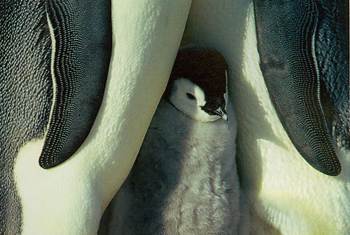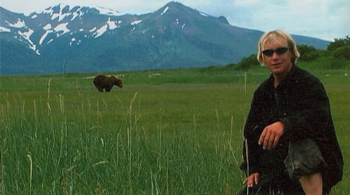 Grizzly Man
Grizzly Man
Werner Herzog, Director
Lions Gate Films, 2005
March of the Penguins
Luke Jacquet, Director
Warner Independent Pictures, 2005
Look: What is nature? What is death? And who’s looking? These are pivotal issues in trying to understand two new documentaries about the natural world, Werner Herzog’sGrizzly Man and Luc Jacquet’s March of the Penguins.
Visually the two films could not be more different. Grizzly Man takes place in an Alaskan forest worthy, at times, of The Blair Witch Project. Penguins unfolds in a vast Antarctic icescape whose subtle gradations of blue and rose suggest a canvas of Georgia O’Keeffe. Grizzly Man’s characters are few and intense: bears, foxes, and humans. The focus in Penguins is on great homogeneous groups as we see them march and belly across ice fields, huddle against the cold, sport, mate, and tend to their young en masse.
In Penguins, to die is to “simply fall asleep and disappear” into the vastness, but in Grizzly Man, it is a horrific, unjust event. We see the “Grizzly Man,” Timothy Treadwell, naturalist, eco-activist, child eternal, tearfully cradle a dead baby fox, mourn a bee found dead on a flower petal, and rail against God for withholding rain. Without rain to swell the river and bring fish to the grizzlies, they will eat their babies or starve: “It just doesn’t seem right!” The untimely crack of a penguin’s egg fallen to the hard ice, frost invading tender innards in time-lapse agony, though the parent keens, is delivered in timeless perspective, one egg among many, one generation among many.
Treadwell is front and center in nearly every shot of Grizzly Man. Nature happens in an upstage corner. Everything is mediated by Treadwell’s sensibility. He has set a video camera on a tripod. He preens for the camera, brushes blond bangs aside, tries take after take to varied phrasings. Treadwell sets the tone. Like Adam, he has named the animals, and they are human names: Timmy Fox, Ghost, Mr. Chocolate. Treadwell’s animals are humans in exotic skins: He treats them as friends and family. Occasionally, however, there is blood; for Treadwell himself is part of a larger palette, that of director Herzog, who has selected and arranged the footage to convey his view.
By contrast, the eye through which we see the penguins is seen by us only at the end, as credits roll. In a small frame in the lower right corner, there is footage of the camera crew in their parkas setting up equipment as penguins poke about. Finally, the frame dissolves, like a gently dying penguin, into the surrounding black. Is this film, then, more objective thanGrizzly Man?

Consider the two soundtracks. Penguins is all sad sweetness (flute and harp), or jocular (bassoons), or heroic (strings). Think of Debussy and Faure. Whereas in Grizzly Man pivotal moments are marked by the ominous buzzing of flies—the Furies: the aviator, at the film’s beginning, as he describes to Herzog the discovery of a corpse at the campsite, and Treadwell, in his final take, whose bear-ravaged corpse the aviator will discover, are circled by flies. Herzog’s sound effects artist must have been at considerable pains to heighten the ominous drone. “Chaos and hostility,” asserts Herzog, are the essence of nature.
Isn’t that the First Noble Truth? That being and suffering are inseparable? Only here there is a bitter note, as if there were not three more Truths in store, but only this one, this lonely ontological catastrophe.
Treadwell is both monkey and monk. In the Chinese folk classic Journey to the East, the self-dubbed Handsome Monkey King, ego personified, who will even piss on the Buddha’s fingers to prove that nobody’s his better, is taken in hand by the stern monk Tripitika. In outtakes revealed by Herzog, we see Treadwell, as Monkey and bursting with vitriol, curse the Park Department in the foulest language. “Fuck you. I beat you, you fucking losers. Animals rule. Treadwell wins.” But elsewhere: “I will die for these animals” and “If there was a God, God would be very pleased with me. I feel good about myself.” His death was, in a way, reminiscent of the death of the bodhisattva in the Jataka tale who gives himself to be eaten by a hungry tiger. Disarmingly, Treadwell opens himself to the camera, too. He shares all his secrets, even musing about his sexuality, and his troubles with women.
But Monkey Treadwell crosses forbidden boundaries. Living among the bears, videotaping, then lecturing, organizing committees, visiting grade schools, he sees himself as the grizzlies’ heroic savior. He bestows upon himself the title “the kind warrior.” (Read: Handsome Monkey King.) In a close shot, holding a mudra, he pronounces: “I will be master.” Yet a number of Herzog’s interviewees consider Treadwell a villain. A tribal official decries Treadwell’s violation of the sacred border between animals and humans. A state trooper opines that he got what he deserved. Treadwell knew that he was playing a dangerous game, but he believed that his rapport with the beasts would preserve him. Herzog knows better. In the grizzlies’ eyes, where Treadwell saw affection and mutual respect, Herzog shows us “overwhelming indifference.” It is the old debate, Hobbes versus Locke on the “state of nature”: peaceable kingdom, or red with tooth and claw?
Says Lao Tzu: “Nature, immune as to a sacrifice of straw dogs, faces the decay of its fruits.” We humans are more partial. It’s unusual not to prefer things. Penguins, for example, are more loveable than grizzlies, by and large. Their eyes are round and dark. They are beautifully feathered, white and black with sunrise-colored chin feathers. They walk upright, as we do, and have a charming waddle. And they don’t eat people. Plus, Jacquet does all he can to make them endearing. The rigging of the deck shows through in the one scene of animal savagery, when a mother penguin is devoured by a leopard seal. The penguins, to the camera, are soft curves, warmly hued feathers, and amorous propinquity; even the negative spaces between them, in the flock, have lovely contours, whereas the leopard seal is shown as dark, sharp, and hideously undulating. The camera aims directly into its jagged maw.
Well, they could have shot the penguins that way, too. They could have been villains, savaging poor fish. And talk about familial dysfunction: the females abandon the males, then the males the females, for months at a time, to go and eat. Instead, it’s all made heroic. The eye is all. It is not insignificant, perhaps, that the camera crew allowed a few penguins to die; that is, we watch them die, when, at any moment, a cameraperson could have run out and saved it. Forty years ago another nature movie, Mondo Cane (i.e., “Dog’s World”), showed a sea turtle, injured by nuclear fallout, circle aimlessly until it fell dead, starved. The narrator had a sardonic, superior tone. That movie decried the stupidity and destructiveness of us humans. But the moviemaker—a human, after all—could have saved the turtle, too.
Look: What is nature? What is death? And who’s looking?
Herzog’s is a bitter and worldly-wise voice. March of the Penguins’ voice is Morgan Freeman’s, sweetly avuncular. But there’s no taking sides here. These are two stirring films. The character of nature and of death depend, it seems, on the eye, on the voice. The more time the camera spends on the human players, the more contradictions and strife turn up. Else, with Bodhidharma, it’s “vast emptiness with nothing that can be called holy.”
Thank you for subscribing to Tricycle! As a nonprofit, we depend on readers like you to keep Buddhist teachings and practices widely available.